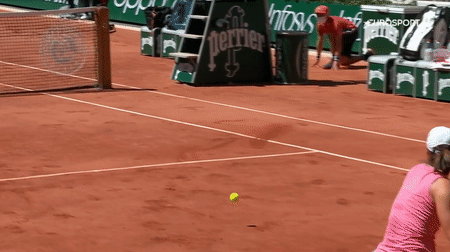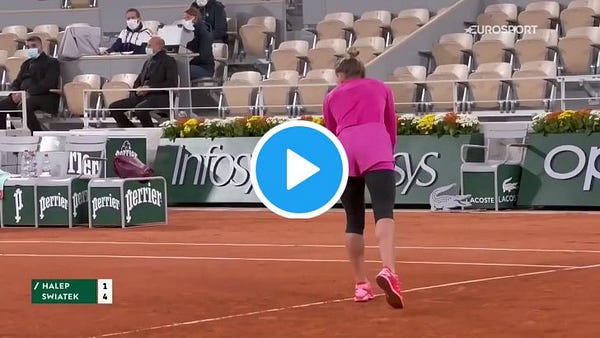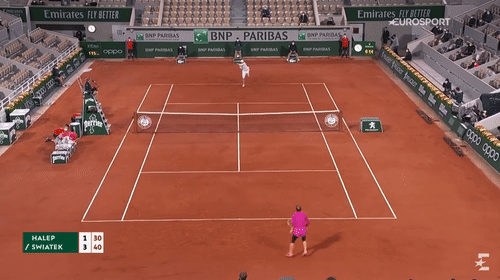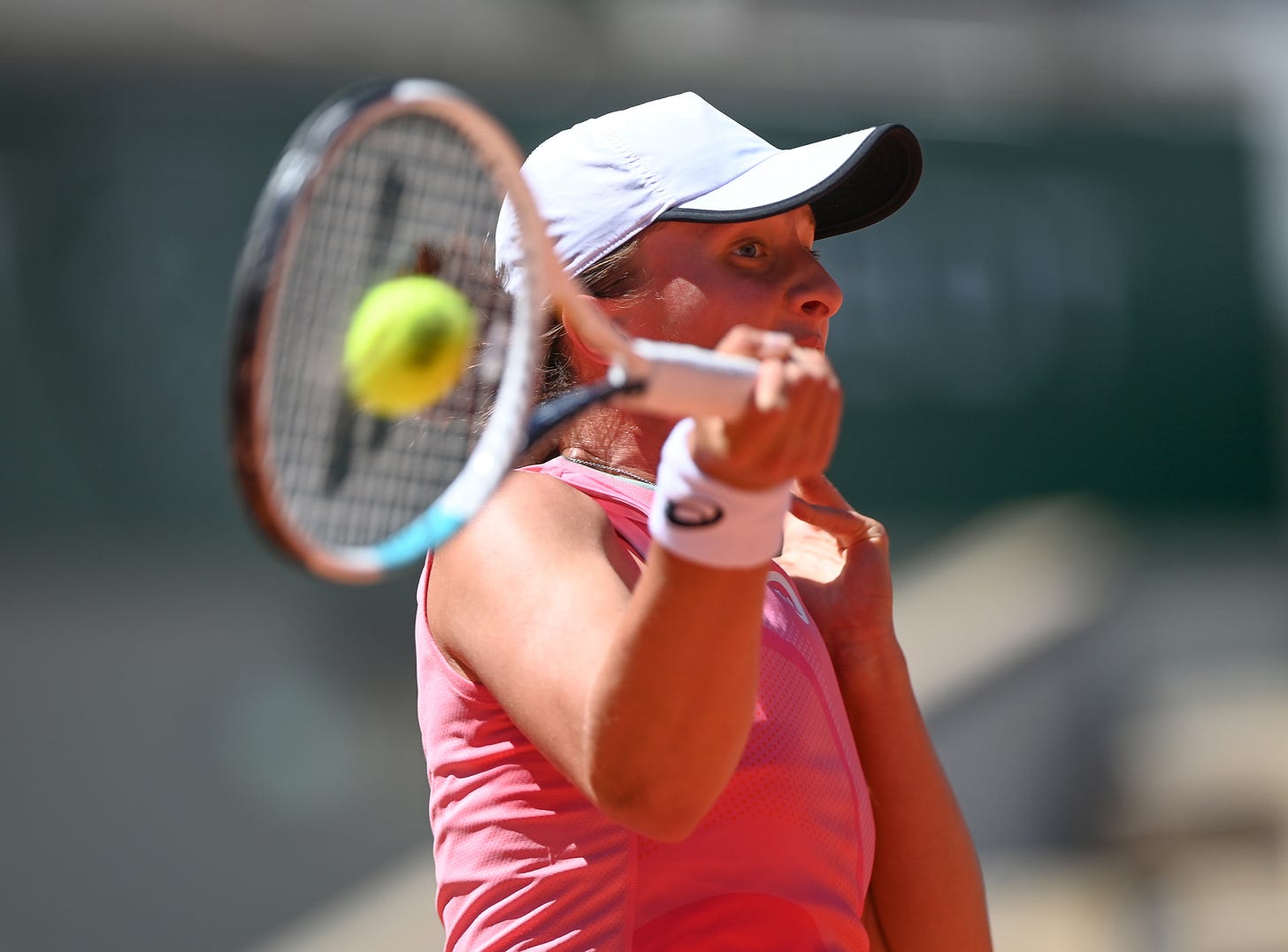Player Spotlight: Iga Świątek
Iga Świątek turns 20: analysis of her high margin groundstrokes and balanced movement
Iga Świątek turns 20 today, but the Polish prodigy has already won Roland Garros and the Rome Masters, and comes into this year’s French Open as one of the favourites.
Today Świątek notched her 28th tour level win on clay, beating Kaja Juvan 6-0 7-5, for a 23 wins and 5 losses record (82%).
Let’s take a look at how her early-career record on clay stacks up against some of the game’s best, and some recent, clay courters.
First 28 tour level matches on clay (open era):
Monica Seles: 27 wins 1 loss (96%)
Iga Świątek: 23 wins and 5 losses (82%)
Chris Evert: 23 wins and 5 losses (82%)
Justine Henin: 21 wins 7 losses (75%)
Serena Williams: 20 wins 8 losses (71%)
Maria Sharapova: 19 wins 9 losses (68%)
Martina Navratilova: 17 wins 11 losses (61%)
Steffi Graff: 16 wins and 12 losses (57%)
Amelie Mauresmo: 15 wins 13 losses (54%)
Ashleigh Barty: 15 wins 13 losses (54%)
Simona Halep: 13 wins15 losses (46%)
Margaret Court’s first 28 matches came before the open era started, but her record was 27 wins and 1 loss.
Early career win/loss records are not the be all and end all. Nor are they always an accurate predictor of future success. Steffi Graff’s 57% win rate for her first 28 matches, despite going onto to be one of the greatest clay courters ever, is a good example of the potential misdirection of this metric. And Ashleigh Barty (perhaps Świątek’s biggest rival in Paris this fortnight), after having a bit of a bumpy start to her clay career, is now 23 wins to just 5 losses in her most recent 28 matches on the red stuff.
But such a glittering start to a career certainly doesn’t hurt. Świątek has laid down some very strong foundations on her favourite surface.
Groundstrokes
Iga Świątek’s idol is Rafa Nadal (the two got to hit with one another in Paris a couple of days ago). Rafa’s impact on men’s tennis has been large, with him and others ushering in the peak of an era of high margin offence and defence, enabled partially via topspin and net clearance. Some of this has translated to the women’s game, and Świątek is certainly not the first women’s player to use a western, spin-friendly grip, on her forehand. But the Pole’s brand of extraordinarily balanced, high-margin tennis can occasionally look quite distinct from the current women’s tennis meta, which is full of equally impressive, if more linear, flatter hitting power. If Frankenstein was in charge of building Świątek, you could imagine him picking various player parts of greatness to throw into the terrifyingly effective hybrid. The elastic on-the-run strength of Kim Clijsters, the open-stance, sliding backhand of Novak Djokovic, and topping it all off with the devastating high-margin forehand of Rafa Nadal1. The resulting monster is one that has all the tools to dominate clay for years to come. To be clear, Świątek’s game-style is going to work on all surfaces (even if that extreme grip may occasionally get rushed on quicker courts), but given we’re in Paris at the moment, I thought I’d dive a bit deeper into why it has such a good chance of shining so brightly on clay in particular.
Never was this juxtaposition of ball flight and margin, between Świątek and some of her peers, more apparent than in last year’s Roland Garros final. Świątek faced Sofia Kenin, the similarly young American who has grown up largely on hard courts rather than clay. Świątek managed to win easily in straight sets, showing no signs of nerves despite it being her first Slam final, but it was the play-style differences which were most interesting to watch.
Peak forehand spin rates during the the 2020 Roland Garros final:
Kenin's 1920 RPM
Świątek's: 3453 RPM
Świątek simply had so many more options than her flatter hitting opponent throughout that match. The greater spin rates, more extreme grip and wristy flicks, and overall dynamism on her forehand opens up all sorts of optionality when it comes to creating angles, and safer aggression, on clay that flatter hitters don’t enjoy so easily. Clay has always been the surface which most generously rewards and enables using all areas, angles and dimensions of the court, and Świątek’s skill set certainly gives her an advantage in this regard:
Today vs Juvan:


Of course it’s not just Świątek’s forehand that does the damage. While much flatter, her backhand has effortless power, especially when hitting down the line. Her changes of direction on her backhand are stunning, and consistently hard to read.
Balance
Equally, if not more, important as Świątek’s groundstroke technique however, are her balance and foot skills as she’s hitting these shots. Something that stood out clearly in her very impressive win over Halep at Roland Garros last year, was her ability to use the powerful but safe groundstrokes mentioned above, built on top of a foundation of movement that makes her unbelievably hard to outmanoeuvre.
Better quality streamable link 🎥 here.
Twitter link:


(If you can, load up the video side by side to this paragraph for reference) This point is played at a brilliant tempo, with both Świątek and Halep crushing the ball. But the most interesting thing about the point is watching what both players do just after making contact. Świątek always looks one step ahead of Halep, with Halep just taking an extra half-second to recover after taking her big swings. Conversely Świątek moves with this sort of uninterrupted, open-stance, flow through contact, more effortlessly pushing back to the middle of the court to recover for the next shot. This has the effect of Świątek being more active than reactive, and the opposite for Halep. With this greater, balanced flow through her shots, Świątek is able to create more space to hit into and more time on the ball, for her angled forehand to exploit. The last few shots are particularly telling, Halep always trying to be the one catching up to the ball hitting on the run, Świątek working angles hitting through the run.
This combination, of having these reproducible, higher margin weapons than many of her opponents, on top of a wonderfully balanced foundation of movement through contact, leaves Świątek with all the tools needed to succeed on the red clay. Her serve and volley skills need work, and will get work, but the rest of her game is already hugely exciting on her 20th birthday.
It would be normal if Świątek didn’t defend her Roland Garros title, indeed that is the expectation given stiff competition. But at least from the early signs of her career, not much about Świątek is normal.
Frankenstein’s creation of the modern baseliner is already an unusual success.
— MW
See you on Thursday (p.s more in depth stuff on Świątek coming soon)
Twitter @MattRacquet
If you have any questions or thoughts about what you just read you can leave a comment below & I’ll answer it. No question is dumb.
// Looking for more?
Osaka Boycotts The Press: https://theracquet.substack.com/p/naomi-osaka-boycotts-the-press
Federer Redux - The Iceberg Flips: https://theracquet.substack.com/p/the-federer-redux
Rome Final Analysis - Nadal vs Djokovic: https://theracquet.substack.com/p/rome-final-nadal-vs-djokovic
Stop Screwing Umpires On Clay: https://theracquet.substack.com/p/lets-stop-screwing-the-umpires-on
Analysis of the Tsitsipas vs Rublev Monte Carlo Final: https://theracquet.substack.com/p/monte-carlo-final-tsitsipas-vs-rublev
Do Flatter Hitters Have it Harder On Clay? https://theracquet.substack.com/p/daniil-medvedev-does-not-like-the
The Modernisation Of Tennis: https://theracquet.substack.com/p/the-modernisation-of-tennis
Tennis’ Identity Crisis: The Umpire Problem https://theracquet.substack.com/p/tennis-identity-crisis
Analysis of the Djoković Medvedev Australian Open Final: https://theracquet.substack.com/p/the-racquet-micro-not-macro-match
To be clear, Nadal’s forehand is mechanically very different to Świątek’s and this Frankenstein comparison was simplistic. He hits with a semi western grip and a straight arm. Świątek hits with a full western and a bent arm. But the end result is not that dissimilar at times with regard to spin rates and net clearances.






